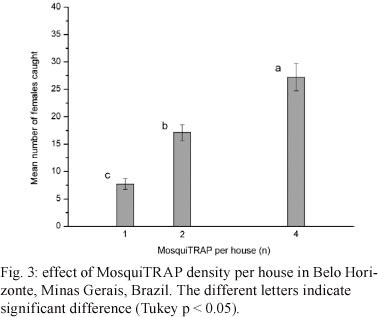A sticky trap designed to capture gravid Aedes (Stegomyia) aegypti mosquitoes, MosquiTRAP, has been evaluated for monitoring this species in Brazil. However, the effects of trap densities on the capture rate of Ae. aegypti females and the sensitivity of vector detection are still unknown. After a preliminary study has identified areas of high and low female mosquito abundance, a set of experiments was conducted in four neighbourhoods of Belo Horizonte (state of Minas Gerais, Brazil) using densities of 1, 2, 4, 8, 16, 32 and 64 traps per block. Trap sensitivity (positive MosquiTRAP index) increased significantly when 1-8 MosquiTRAPs were installed per block in both high and low abundance areas. A strong fit was obtained for the total number of mosquitoes captured with increasing trap densities through a non-linear function (Box-Lucas) (r² = 0,994), which likely exhibits saturation towards an equilibrium level. The capacity of the Mean Female Aedes Index to distinguish between areas of high and low Ae. aegypti abundance was also investigated; the achieved differentiation was shown to be dependent on the MosquiTRAP density.
Aedes aegypti; sticky trap; trap density; Box-Lucas function











